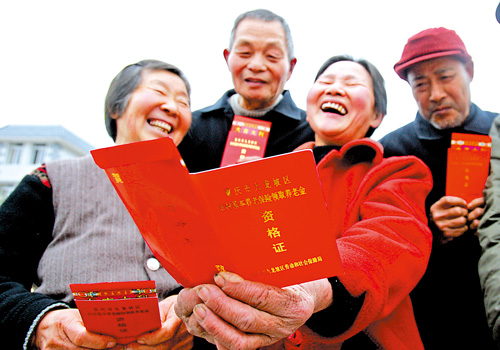Introduction
Establishing sustainable social pension systems in low- and middle-income countries is an urgent task as the growth rate of the senior population in these countries substantially exceeds that of high-income countries (Edmonds et al., 2005).
Analysis of the People’s Republic of China’s (PRC) new rural pension scheme, the world’s largest social pension program, offers a robust case study of the impacts of pension benefits on older persons and their extended families in developing countries.
In particular, our study examines whether increased income for aging parents relaxes the overall credit constraints for households, especially those in poor rural areas, thereby facilitating more independent living for pensioners and better access to crucial services including medical care.
Analysis
Like many developing countries, the PRC’s population is aging rapidly. By 2050, more than 25.6% of its population is expected to be over the age of 65. Moreover, stringent family planning policies during the last 3 decades have contributed to a dramatic increase in the ratio of relatively low-income senior dependents, further intensifying the pressure on a shrinking working-age population to take care of their parents.
Older rural residents living in less developed regions are particularly disadvantaged. In 2010, the poverty rate for rural people aged 60 and above was as high as 22.3%, compared to 7.8% for the rural population in the PRC as a whole (Cai et al., 2012).
The PRC launched the rural pension scheme in 2009 to alleviate some of these pressures and better provide for the basic needs of aging residents. The program now covers almost all counties with over 400 million people enrolled. Considering its scale and the large disparities between rural and urban areas as well as across regions and age cohorts, this pension scheme provides a unique case study of the heterogeneous impacts of pension income.
In analyzing these effects, three questions were asked:
- Does more income for aging parents facilitate more independent living and less co-residence with adult children, particularly adult sons?
- Does pension income facilitate better access to and use of crucial services, such as medical care for seniors?
- Does pension income change pecuniary and nonpecuniary transfers between older people, their adult children, and their grandchildren?
To answer these questions, we examined two detailed household surveys: from Guizhou province, which is one of the poorest areas of rural PRC, and from the relatively well-off Shandong province. In both cases, we tracked each adult child’s living arrangements and demographic information regardless of whether the adult child is counted as a household member. Using both sets of comparative data allowed us to conduct stronger empirical tests.
Taken together, the research design disentangles the effects of pensions from other age-related factors shaping intergenerational relationships, thus contributing to the growing literature on the specific mechanisms underlying impacts of the pension scheme.
Our findings indicate that the pension scheme significantly reduces intergeneration co-residence, promotes pensioners’ consumption of healthcare services, and weakens (but does not supplant) nonpecuniary and pecuniary transfers across three generations. All of these impacts of the pension scheme exhibit far greater magnitudes in the locality with lower income, Guizhou, than the locality with higher income, Shandong.
In looking at intergeneration co-residence, we observed a perceptible reduction in adult sons’ co-residence with parents around the cut-off age for pension receipt, with a larger and more significant effect for Guizhou than for Shandong. Similarly, there is a more salient decline in co-residence between grandchildren and grandparents for Guizhou than for Shandong. Thus, pension income does appear to relax credit constraints most significantly for the poorer rural area and is associated with purchase of greater living space (and privacy) across three generations.
Moreover, the rural pension scheme appears to reduce some nonpecuniary transfers between senior parents and adult children and grandchildren, such as being assisted by children when ill, and to weaken pecuniary transfers between generations.
One interpretation for the finding is that pensioners transfer less money to adult children and grandchildren after household division, especially in Guizhou, and that they instead spend the money on hired services. Another interpretation centered in household division is that separation between older people, their adult children, and grandchildren decreases the level of utility from companionship felt, thereby reducing a grandparent’s monetary investment in a grandchild.
It could also be the case that parents’ pensions contribute to adult children’s rising migration rate and off-farm employment, thus increasing children’s economic resources and decreasing the demand for transfers from grandparents. In any case, the introduction of pension incomes appears to increase the economic independence of older people.
In addition to these multi-generation impacts, pension receipt is associated with greater healthcare consumption among pensioners or greater perceived confidence in consuming medical services when needed. In rural PRC, despite universal coverage by basic health insurance schemes, financial difficulties often prevent patients from receiving or continuing expensive medical treatments.
Our findings suggest that pension benefits may help to alleviate this problem by promoting confidence in ability to pay for necessary medical services, positively impacting both the health and well-being of aging patients in rural areas and allowing family units the option of investing economic funds previously allocated toward the medical needs of senior parents into alternative investments, such as education, additional job training, or relocation.
Policy Implications
Throughout the developing world, adult children often provide the most important form of support for their aging parents, both through pooling of household public goods in co-resident living arrangements and other nonpecuniary support.
Pension payments increase older people’s economic resources, which may promote their economic independence and enable adult children to choose to live in a separate home in the same village or to move further away in pursuit of education or work. Our analysis of the PRC’s pension scheme shows that providing pension income to older persons in rural areas may
- reduce intergeneration co-residence, thereby creating additional economic and migratory opportunities for adult children and grandchildren;
- weaken, but not eliminate, the web of nonpecuniary and pecuniary transfers across three generations, increasing the economic independence of older persons and allowing for immediate family to reallocate economic resources toward options, such as schooling and work opportunities; and
- increase access to medical services among older persons in rural areas, improving their personal health and well-being and reducing the burden of medical expense coverage by extended family.
Our findings help strengthen the rural pension scheme program and thus improve the well-being of older persons and their families across regions in the PRC. They also offer insights into the feasibility of replicating similar schemes in other developing countries that are facing similar demographic challenges.






